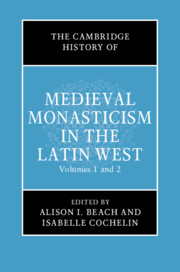Book contents
- The Cambridge History of Medieval Monasticism in the Latin WEST
- The New Cambridge History of Medieval Monasticism in the Latin West
- The Cambridge History of Medieval Monasticism in the Latin WEST
- Copyright page
- Contents
- Figures
- Contributors
- Acknowledgments
- Abbreviations
- 1 General Introduction
- Part I The Origins of Christian Monasticism to the Eighth Century
- Part II The Carolingians to the Eleventh Century
- Part III The Long Twelfth Century
- 34 Historiographical Approaches to Monasticism in the Long Twelfth Century
- 35 Sources for Monasticism in the Long Twelfth Century
- 36 Hermitism in the Eleventh and Twelfth Centuries
- 37 Monastic Theologies, c. 1050–1200
- 38 Monastic Preaching and the Sermon in Medieval Latin Christendom to the Twelfth Century
- 39 The Mass in Monastic Practice: Nuns and Ordained Monks, c. 400–1200
- 40 Reclusion in the Middle Ages
- 41 Similarities and Differences between Monks and Regular Canons in the Twelfth Century
- 42 The Institutionalization of Religious Orders (Twelfth and Thirteenth Centuries)
- 43 Gender and Monastic Liturgy in the Latin West (High and Late Middle Ages)
- 44 Monastic Landscapes
- 45 Later Monastic Economies
- 46 Nobility and Monastic Patronage: The View from Outside the Monastery
- 47 The Medical Role of Monasteries in the Latin West, c. 1050–1300
- 48 East-Central European Monasticism: Between East and West?
- 49 Monasticism, Colonization, and Ethnic Tension in Late Medieval Ireland
- Part IV Forms of Monasticism in the Late Middle Ages
- Index
- References
48 - East-Central European Monasticism: Between East and West?
from Part III - The Long Twelfth Century
Published online by Cambridge University Press: 16 January 2020
- The Cambridge History of Medieval Monasticism in the Latin WEST
- The New Cambridge History of Medieval Monasticism in the Latin West
- The Cambridge History of Medieval Monasticism in the Latin WEST
- Copyright page
- Contents
- Figures
- Contributors
- Acknowledgments
- Abbreviations
- 1 General Introduction
- Part I The Origins of Christian Monasticism to the Eighth Century
- Part II The Carolingians to the Eleventh Century
- Part III The Long Twelfth Century
- 34 Historiographical Approaches to Monasticism in the Long Twelfth Century
- 35 Sources for Monasticism in the Long Twelfth Century
- 36 Hermitism in the Eleventh and Twelfth Centuries
- 37 Monastic Theologies, c. 1050–1200
- 38 Monastic Preaching and the Sermon in Medieval Latin Christendom to the Twelfth Century
- 39 The Mass in Monastic Practice: Nuns and Ordained Monks, c. 400–1200
- 40 Reclusion in the Middle Ages
- 41 Similarities and Differences between Monks and Regular Canons in the Twelfth Century
- 42 The Institutionalization of Religious Orders (Twelfth and Thirteenth Centuries)
- 43 Gender and Monastic Liturgy in the Latin West (High and Late Middle Ages)
- 44 Monastic Landscapes
- 45 Later Monastic Economies
- 46 Nobility and Monastic Patronage: The View from Outside the Monastery
- 47 The Medical Role of Monasteries in the Latin West, c. 1050–1300
- 48 East-Central European Monasticism: Between East and West?
- 49 Monasticism, Colonization, and Ethnic Tension in Late Medieval Ireland
- Part IV Forms of Monasticism in the Late Middle Ages
- Index
- References
Summary
The history of monasticism in the core areas of east-central Europe, cannot be properly considered without adopting a broader historiographical approach to this part of the continent. The medieval kingdoms and duchies that are the precursors of the modern political entities of Poland, the Czech Republic, Slovakia, and Hungary do not reflect their medieval territories. Medieval Hungary also included Slovakia, Transylvania, Vojvodina, eastern Slavonia, and, from the early twelfth century, the kingdom of Croatia under the personal union of Arpad kings. Early medieval Polish territory included Greater and Lesser Poland, Mazovia, Lower Silesia, and, from the mid-twelfth century, some overlordship over parts of Pomerania. The territory of early medieval Bohemia also included Moravia.
- Type
- Chapter
- Information
- The Cambridge History of Medieval Monasticism in the Latin West , pp. 882 - 900Publisher: Cambridge University PressPrint publication year: 2020



